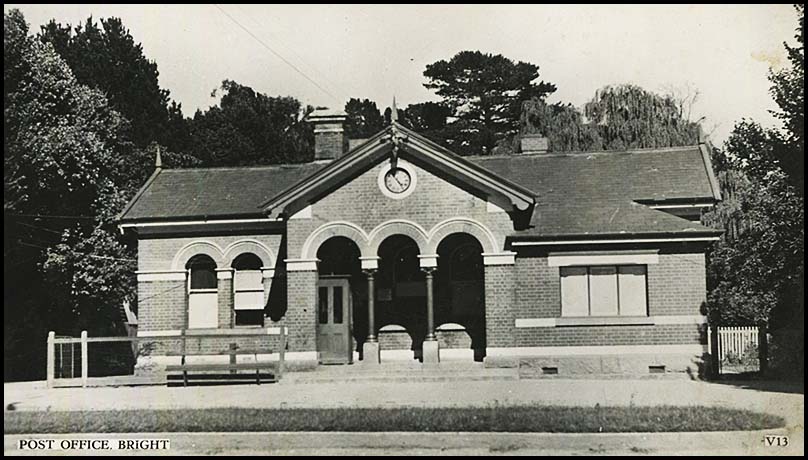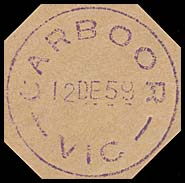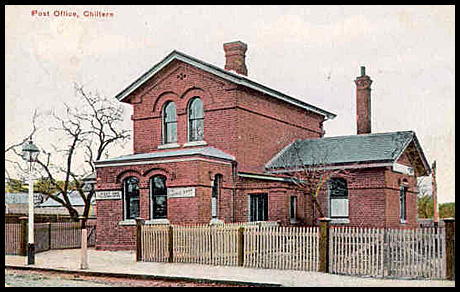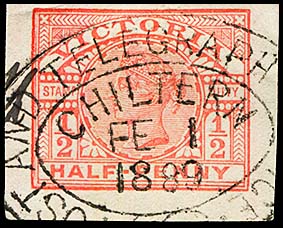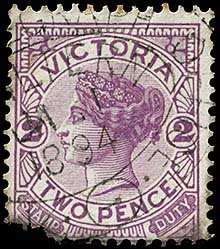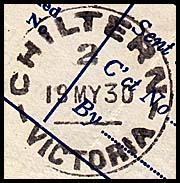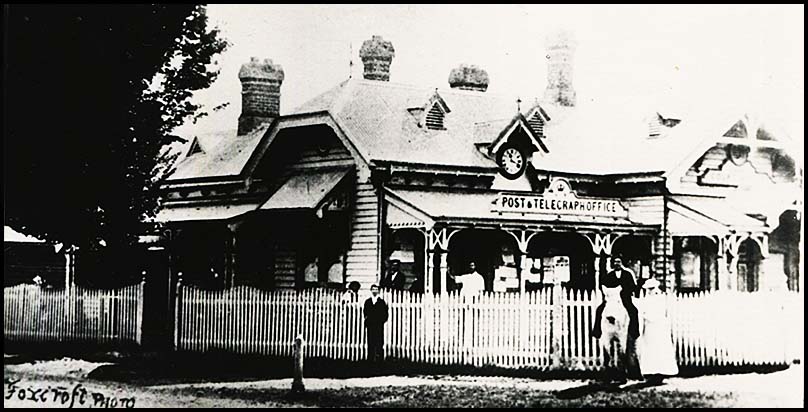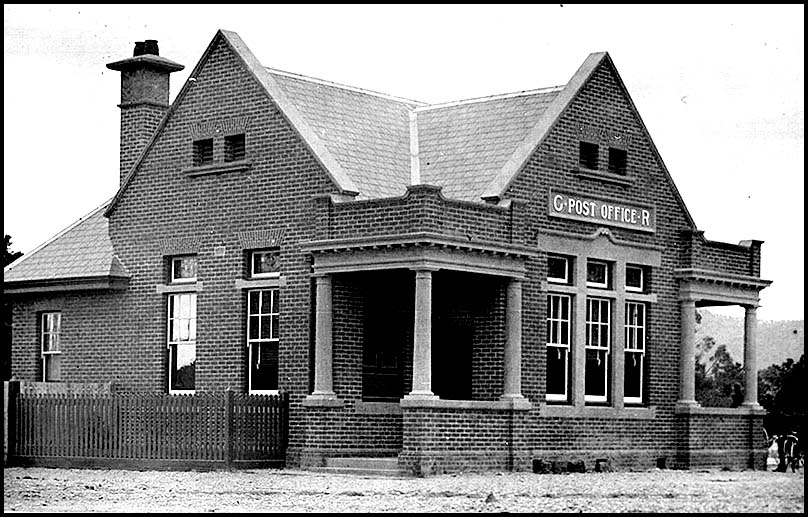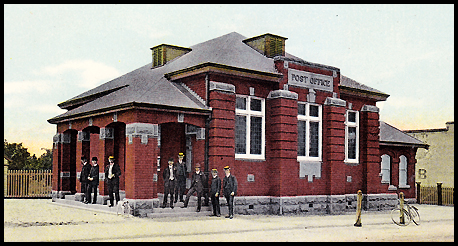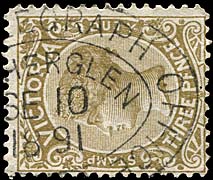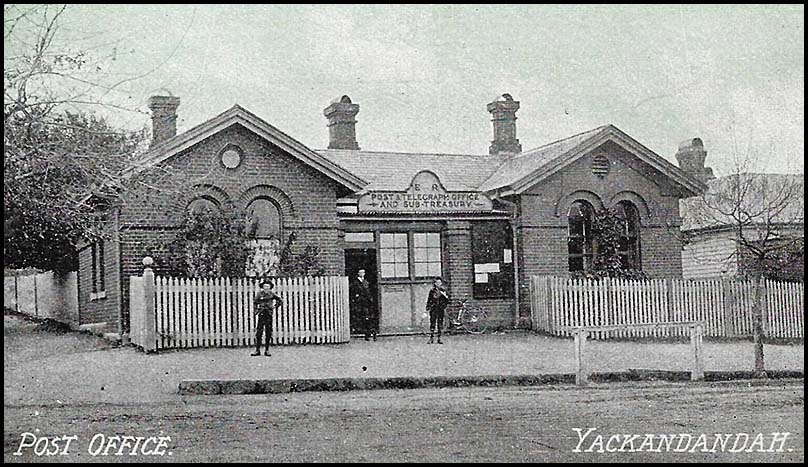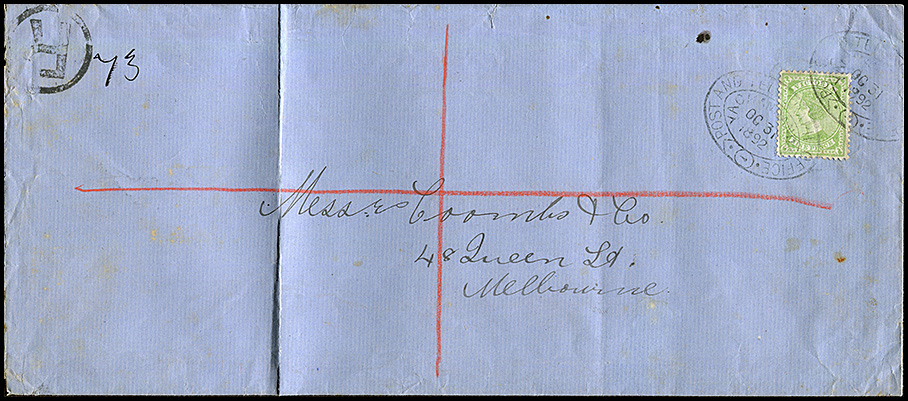Telegraph Offices on the Corowa (No. 3 North East) line.
- Australia 1901-1988
- New South Wales
- Queensland
- South Australia
- Tasmania
- Victoria
- Western Australia
- International
- Special aspects
The following stations were included on the main Corowa Line (No. 3 N.E.) and from the four associated Branch lines. Some Offices listed were also on the other lines but are also included here when there was an overlap between lines.
| Beechworth | Benalla | Bright | Carboor | Chiltern | Eldorado |
| Harrietville | Kilmore | Myrtleford | Rutherglen | Seymour | Stanley |
| Wahgunyah | Wandiligong | Wangaratta | Wodonga | Yakandandah |
| Bright (Morse's Creek).
The Telegraph Office opened in August 1867. The Ovens and Murray Advertiser of 11 May 1867 noted "the new Telegraph Office, Bright, is to be at the former Colonial Bank premises, better known as Mr Bradley's Store, but our correspondent is not aware if that arrangement is to be permanent or only for the time being". It turned out that the arrangement was semi-permanent because the foundation stone for the new Post and Telegraph Office at Bright was laid 12 years later on 19 April 1879 - the same day as for Wandiligong. Details of the proceedings are given elsewhere although it does not describe the actual laying - too much cheering!! A subsequent report in the Ovens and Murray Advertiser on 4 June 1867 noted "The portion of the line of telegraph from Newtown to the Beechworth office, which was not included in the original contract, is now being carried out under the new contract. There has not as yet been any office engaged, or built, or any officer appointed, for the Bright end of the line but we hope it is merely necessary to direct the attention of the proper authorities to the fact to have it remedied". The Age reported on 24 December 1879, that on the previous day, "The authorities "entered into possession" of the newly-erected Government offices at Bright today. Congratulatory messages were forwarded to Mr. J. B. Patterson, Postmaster-General, by the president and councillors of Bright Shire and to Mr. Billson, M.L.A., by the leading residents of Bright. Accommodation is provided for Post and Telegraph and receipt and pay offices for the district as well as officers' quarters. The offices are constructed of red brick with granite base and black and white Brunswick brick dressings. The total cost is £2,000. Messrs. Kaiglin and Sons of Wandiligong were the contractors and Mr. R. Tough, of the Public Works Department, the superintending officer in charge. As there was a demonstration when the foundation stone was laid, which ceremony was performed by Mr. Billson, M.L.A., Messrs. F. Longmore and W. Collard-Smith being present and taking part in the proceedings on that occasion, no special formalities took place at the opening". The town (and the Post Office when it was opened in 1860) was originally called Morse's Creek. In 1866, this name was changed to Bright. In September 1884, the Post and Telegraph Master (Mr. Outtrim) was transferred to Ballarat East and Mr. Kelsall from Cape Otway replaced him. Education was always important and valued in remote areas. In November 1875, the people of Bright were opening a new schoolhouse. As is still the case, about 150 years later, the curriculum (especially in Maths) is hopelessly inappropriate and not related to real life at any level. "It is not before it was time that some steps were taken to introduce Australian class books into the State schools. Passing over the absurdity of instructing children in the names of all the counties,etc., in the old countries and leaving them in profound ignorance of the very name of the county they live in; I may give an apt illustration of the present system, which occurred lately to the writer, who being himself ignorant on the matter, enquired - fruitlessly - to ascertain the number of pounds in a bushel of barley. Not a man, woman, or child in Bright could tell! Not a schoolbook used could tell!". (Ovens and Murray Advertiser, 17 April 1875). |
|
|
The Post and Telegraph Office in Harrietville was being constructed in February 1884 on premises provided by Mr. Wraith - see elsewhere. The Telegraph Office was finally opened in Harrietville on 10 September 1884. The Argus of 23 August 1884 updated readers as to developments: "The Harrietville bag is not a very heavy one. The post-office at present is at Mr. Jones's store, which forms a lounge and meeting place for the boys and girls whilst the letters are being sorted. But a new building to serve as post and telegraph offices has just been completed, and will shortly be occupied. This and the police station are owned by a private individual, and rent is paid for both, whilst a few yards further on there is a paddock, a Government reserve, on which all the public buildings could have been erected. Besides the space occupied as business premises, the new building possesses four good rooms a kitchen and servant's bedroom outside, and a good garden. All this, I understand is for the requirements of the young lady operator, who is to be sent from Melbourne or appointed from a nearer quarter. The forthcoming advent of this new post-mistress is causing great commotion and curiosity in Harrietville. It is rumoured that extensive orders for new clothes have been given by the bachelor miners. The church which the young lady attends will receive an accession of worshippers. There is no doubt that she, if good looking, will take the cake here, and will have the monotony of her existence pleasantly varied in sorting and appraising the claims of her lovers. Some of the softer sex here grumble, and say they cannot see the need of new postal arrangements - Jones always did the work and satisfied them. A woman will be too curious respecting the letters she sorts! The extensive preparations for the accommodation of a single girl do seem rather absurd, but an 'operator' is wanted. The completion of the telegraph wire here will be a great convenience in the forthcoming summer, when visitors to the Alps should telegraph to Mr Allen, that they may not find themselves without accommodation on their arrival". Harrietville was apparently named after Harriet Murphy - the first white woman ever seen there. |
|
The Telegraph Office was established in May 1879 - about 12 years after the Buckland riots. The Post Office had been opened as Myrtle Creek and it changed name to Myrtleford on 1 January 1871. But in the Ovens and Murray Advertiser of 23 February 1884, an amazing issue is raised: "Then, again, where is our Post and Telegraph office? Only in the old spot, and conducted on the same principle — viz., occupied by the Government rent free, at the expense of three gentlemen whose interests demanded that a Telegraph Office should be opened here. This is about the meanest transaction out. The Government have had the premises for about five years free of charge, and now they are asked to pay rent, they kick and want to open the office at the railway-station. This may be all very well in the eyes of the department, but will not "wash" with the people in this part. They will never consent to have to travel half or three-quarters of a mile to post a letter. We want to know the reason why we cannot have a Government building erected here as well as elsewhere. In addition to this, we require a court-house; and why should not the two be built conjointly?". On 15 May, the same source reported: "A public meeting, re postal and telegraphic arrangements, was held at Myrtleford on Monday. Mr Thos. Mathieson, J.P. was voted to the chair and explained the object of the meeting. He stated it might be supposed that he had some pecuniary object in view as he had an interest in the office previously occupied ; but he could state that the Post Office which the Government had used for some time previously, had been offered rent free, rather than that people should have to put up with the present inconvenience. The Rev. M. O"Connor stated that the people of Myrtleford had an interest at stake, and he should have liked to have seen a much larger attendance than was present; but, owing to an article that appeared in the 'Alpine Observer' stating the matter "had been satisfactorily settled (which after events proved was a mistake and the shortness of the notice given, he thought it best to adjourn the meeting to a future date. He could not see why the people of the township should be snuffed out and treated in the contemptible manner in which they had been; and he would move that the meeting be adjourned until the 20th inst. Mr E. C. Chambers, in seconding the motion, stated that he considered the Myrtleford people had a just and a right cause to demand Government Post and Telegraph offices, a receipt and pay office, and other arrangements pertaining there to. Mr Mathieson remarked that it had been pointed out in the public Press that Myrtleford had been gazetted as a Government township for 30 years and that not one penny of Government money had been spent therein. The local correspondent had evidently forgotten one fact, and that was that the Government had really, and actually, built a log lock-up, doubtless for the benefit of the townspeople. After a vote of thanks to the chairman, the meeting was adjourned to the 20th inst. The adjourned meeting took place as scheduled and is reported elsewhere. It appears that the deputation which had met with the Postmaster-General and with Mr. McGowan encountered significant Government obfuscation. On 7 June, the Ovens and Murray Advertiser noted that "The petition praying for the erection of the Post and Telegraph offices at this place has been very numerously signed, and will be forwarded without delay to our members. The removal of the offices from the town to the railway station has raised quite a storm of indignation amongst the townspeople and those living in the neighborhood". Nothing had happened by the beginning of Ausgust and it was reported that people were again to talk about the matter and, if still nothing happened, "it would cause further action to be taken". And an update on 18 September 1884: "We are still in the same fix with regard to our railway arrangements. The manner in which we are treated is simply scandalous. What between being unable to make use of the railway for travelling purposes to any place in the district, our Postal and Telegraph arrangements and our station accommodation, it is the most monstrous injustice, I think, ever inflicted on a civilized community. Our building for Post and Telegraph duties, issuing railway tickets and accommodation is a wooden one, about 2.1 m high by 6m × 3 m 7 feet high, and 20ft x 10ft in length. There is no retiring room or waiting-room for ladies, a thing which scarcely the most uneducated savage would think of neglecting to provide where railways are in existence. It is to be hoped, at all events, the latter cause of complaint will be speedily remedied, if only for the sake of public decency". So not much real progress!! A change of some kind happened because, the Ovens and Murray Advertiser of 22 November 1884 reported "Our Post and Telegraph offices, which we fully expected to have commenced shortly, are to be delayed for another year as it appears there has been no money placed on the Estimates for them. So much for promises in high quarters: they are like pie-crust, only made to be broken". In a wonderful description of the countryside surrounding Myrtleford published in August 1884 , it is also noted that: "The people here, indeed, appear to have had little influence in getting any concessions from the public authorities or the public purse. The terminus of the railroad is quite out of the town, and the Post and Telegraph offices are at the station. One lad unites the offices of postman and telegraph messenger and, whilst he is delivering letters, important despatches have to wait his return". |
|
|
|
|
|
| Only one format for a Myrtleford date stamp related to Telegraph work is recorded. It is a RO2-T format : |
|
|
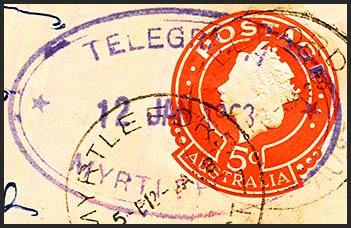 12 December 1968. Used on a PSE with a 5c QE2 indicium. |
Personnel: May 1879: "A Post and Telegraph office has been opened at Myrtleford, Mrs Colden, the widow of the late Dr Colden, having been appointed Postmistress. We feel sure that this lady's numerous friends in these parts will, with us, wish her every success in her new sphere of labor, for which she is eminently fitted" (Ovens and Murray Advertiser 27 May 1879). |
|
A Belt & Buckle date stamp was issued to the Rutherglen office.
|
Provenance: Freeman. |
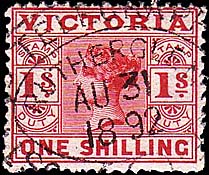 31 August 1892.
|
|
The Telegraph Office at Wahgunyah was opened for the transaction of public business on 8 February 1861. The Gazette of 18 December 1860 had announced that the tender of Wm. Bolger had been accepted for the construction of Telegraph Offices at Chiltern, Wahgunyah, Yackandandah and Snapper Point for £780. Wahgunyah was an important locality for two reasons:
Hence newspapers would often carry notices such as: "The Gundagai River Murray steamer, arrived at Wahgunyah on Wednesday from Adelaide with supplies. She will leave on her return voyage today or tomorrow" The Post Office had opened on 1 July 1858. The All Saints Estate winery was established in 1864 at Wahgunyah with its beautiful extensive cellar building. In addition, the Uncle Toby's breakfast cereal division of Nestlé operates on the outskirts of Wahgunyah (sadly without telegraph facilities). Personnel: 1 November 1860: Roderick Kilborn was appointed Manager of the new Telegraph Office at Wahgunyah. |
|
Wandiligong was on a separate branch from the Corowa line starting from Bright. The Ovens and Murray Advertiser of 19 November 1874, in an article discussing the economic outlook for the general area, noted "Morse's and Growler's Creeks, or to use the new name by which it is to be known - "Wandiligong" - after two years of prosperity shows symptoms of change". To save anxiety, it is now noted that the Post and Telegraph Office opened on 19 January 1885. Miss Nelson was transferred from Kilmore in April 1885 to take charge of the Post and Telegraph Office. But the preceeding events are breathtaking - so read on.: The Ovens and Murray Advertiser of 22 April 1879 carried the following: THE NEW POST AND TELEGRAPH OFFICE AT WANDILIGONG. The Hons. the Minister of Lands and the Minister of Education, and Mr George Billson, ALP., arrived here at 2 p.m. today to assist in laying the foundation stone of the new Post and Telegraph office. A large number of people, headed by the Wandiligong brass brand, proceeded down the road and gave the visitors a hearty and enthusiastic reception. After partaking of some of Mr Blummer's excellent vintage, the whole party, preceded by the band, proceeded to Mr. May's Empire Hotel. After refreshing the inner man, the members of the Reception Committee waited upon them and escorted them to the Shire Hall where the members of the general committee were assembled. No time was wasted, and a move was at once made to the site of the newPost and Telegraph office, for the purpose of effecting the object for which these gentlemen had been invited — viz., laying the foundation stone. The secretary read the address of welcome, thanking the Ministers and Mr Billson for their liberality in regard to this building, and their acknowledgment of our requirements for more extended postal convenience. The copies of documents, etc. , were placed in their resting place. Mr Billson, who had been selected to lay the stone said he was proud of the honor conferred on him by being selected to perform this ceremony, and also at the enthusiastic reception the Ministers and himself had received. He could scarcely find language sufficiently strong to express the pleasure he felt. All his actions were always done with one aim, viz., to benefit his constituents and he should always continue so to act. The Post Office should have been built ten years ago. and to the present Government was due their thanks in bringing this to an issue; others, when in power, had promised to do this, but it appeared something always prevented it (Cheers) Personally he had to thank the present Ministry for their liberality; he had only asked for £1,000 in the first instance but, when the plans and specifications were prepared, it was found that £2,000 would be required and the Postmaster-General at once agreed to the expenditure. (Applause) The address and scroll presented to him that day would be treasured by him and would be a remembrance of one of the proudest days of his life. The honor conferred on him had been totally unexpected, hence his pardonable pride at this unexpected mark of the confidence of his constituents in this district. The present Ministry were doing all in their power to benefit the large majority of the population, and there was little doubt that while they followed this course they would receive their support, and his also. (Cheers.) He was not wedded to this, or any other Ministry and, if any other Ministry came into power advocating sound measures on the same principle, he would support them. He would repeat that all his actions were done with the view of benefitting constituents. He would again thank them ost cordially for the manner in which the Ministers and himself had been received. Three cheers were given for Mr. Bilison, and another three cheers for the Ministers. A silver trowel, suitably inscribed, was then presented by Mr Wm. Hooper, President of the Shire Council, to Mr. Billson who proceeded to lay the stone.. This having been done and the stone declared to be well and truly laid, the assembly lustily cheered Mr Billson and the Ministry and then dispersed until the hour for the banquet arrived at which everything passed off most satisfactorily.". Quartz was first mined in the area but the emphasis soon turned to gold: "A fine cake of retorted gold weighing 1,742 ozs. 10 dwt., About 50 kgs - and about A$4.6 million in today's prices. was yesterday exhibited by the Bank of Australasia. It is the largest cake yet produced in the Beechworth district and is the product of the Myrtle Reef, Bright This reef is situated at Wandiligong and has produced, since its opening, 2,885oz. of retorted gold from 1,770 tons of quartz - or at the rate of 4oz. 15dwt. to the ton. Its width at the present workings is 179ft. drive is 4ft". On 3 August 1882, the Ovens and Murray Advertiser noted the continuing request from residents for a Telegraph Office to be built at WandiligongThey did of course still have the foundation stone.. In 1884, an excellent article was published about the countryside around Myrtleford and Wandiligong. On 17 November 1884, The Argus reported "Great dissatisfaction exists at Wandiligong at the action of he Postal Department with reference to telegraphic extension to that place, Sometime ago a poll was taken to decide upon the site of the new offices, which the Government had promised to build, and now, after a lapse of several months, although the site chosen when the poll was taken has been purchased, communications have been received to the effect that, if a suitable building can be obtained, it will be rented. At a public meeting held last night it was resolved to request the Government to use the building now occupied as a Post Office, it being on the land recently acquired by the department, and to make such alterations as are necessary to render it suitable for a temporary Telegraph Office". In December 1884, tenders were shortly to be called for the erection of Post and Telegraph Offices at Wandiligong. The Argus or 19 January 1885 reported that "The first telegram sent from Wandiligong was despatched on Saturday (17th) by the Governor Sir H, B. Loch, who with Lady Loch, had been spending some days amongst the picturesque scenery of the North-Eastern district. It was addressed to the Premier and was as follows: "I send you the first message that has been sent from this office. We have had a most hearty reception at Wandiligong". There was never again any reference to the Foundation Stone of 6 years previously -:( The Gazette of February 1885 recorded that the tender for the construction of the Post and Telegraph office including fencing at Wandiligong had been let to Robert Hedge for £820. The Ovens and Murray Advertiser of 29 June 1895 raised the following issue: "Retrenchment knife cutting too deep. The action of the Post and Telegraph Department in dispensing with the services of the Telegraph Messenger connected with the Wandiligong office, and abolishing the letter receiving boxes at Maddison's and Wallace's places of business at the south and north ends of the township respectively, was the occasion of a public meeting of dissatisfied residents at the M. U. Hall on Saturday evening. There was a large attendance and the meeting was thoroughly representative of all local interests. Cr. Kaighin was called on to preside and Mr. W. J. Laugher was appointed Hon. Secretary. The Chairman remarked that his task was a very light one. The gentlemen who had convened the meeting were of opinion that the residents of the locality were not fairly treated in being deprived of the services of a telegraph messenger and the numbers that were present that evening showed the inhabitants of Wandiligong had been subjected to a grievance which it was hoped the meeting that evening would assist in redressing. All that devolved upon him, therefore, was to state the purpose for which the conveners had called them together, and ask the meeting to adopt such resolutions as they might consider would secure the restitution of their rights as a community. Mr. T. Jones, expressed himself as being altogether taken by surprise at the action of the Post Office authorities in removing the messenger from Wandiligong. The delivery of letters, as it had only been a partial service, was not of much importance, but the non-delivery of telegrams meant that the benefits of a local telegraph office would be more apparent than real, as people would not send telegrams when the purpose for which they had been dispatched might have gone by before they reached their destination. He thought to express themselves in no unmistakable manner and concluded by submitting the following resolution: "That we, the inhabitants of Wandiligong, in a meeting assembled, strongly protest against the action of the Postal Department in removing the telegraph messenger from the local Post Office, as the residents have suffered great inconvenience during the past month (since his removal) both in matters of business and otherwise". (Applause.) Mr. F. Greenness, in seconding the motion, said the public of Wandiligong had given the "No messenger" system a fair trial for over a mouth, and he had no doubt they could go to the department with confidence and have their grievances redressed. On being put to the vote, the motion was adopted unanimously with cheering. Mr. E. W. Duncan cordially endorsed what had been said by previous speakers and expressed the opinion that if the position of affairs were only properly represented at headquarters the importance of the place would result in the recent decision being reversed. So that they might go to the Department with a definite request, he moved "That in view of Wandiligong being the largest center of population in the Ovens electorate, and owing to the recent development of mining on an extensive scale, the permanent residents are increasing in numbers and the facilities afforded by the telegraph office can only be partially utilised when there is no messenger in connection with the office, we are of opinion that a fresh appointment should be made at once as a simple matter of justice. (Cheering) Mr. W. Radcliffe was astonished, as he believed everybody else was, at the injustice done to the most largely populated centre in the Ovens electorate by the removal of the telegraph messenger and abolition of the letter receiving boxes. Besides having the largest resident population from eleven to twelve hundred, Wandiligong took the lead in the Ovens for gold production, and he (Mr. Radcliffe) further pointed out from the number of letters and newspapers passing through the office and telegrams despatched that the postmistress was entitled to an assistant. The inconvenience a large number of residents at the north end of the township had been subjected to by the abolition of the letter receiving box was quite unwarranted by the small saving effected, especially as the box had been an established institution for about a quarter of a century, the greater portion of the time at no cost whatever to the Government. The receiving box at the south end of the township had been a boon to the residents of Upper Morse's and Growler's Creeks, and he considered the re-establishment of these boxes should be asked for at the same time as the re-appointment of the telegraph messenger. Mr. Radcliffe, in conclusion, stated that since there had been no messenger in connection with the telegraph office, the number of telegrams received had fallen off materially and no doubt would continue to do so, for shareholders in mines and other business men would not send messages to a place where they would lie on a rack in the office instead of being delivered. Retrenchment of that kind defeated the object in view, for while it secured a saving in expenditure, the receipts were reduced to a greater extent. With the addition that he had suggested respecting the receiving boxes, he had pleasure in seconding the motion. Mr. T. G. Smith spoke in support of the resolution. He approved of retrenchment in the Government service for, in many respects, the expenditure had in the past been excessive, but he decidedly objected to the manner in which reforms had been carried out. With all their important mining interests and large population, they were not allowed even a boy at the trifling cost of a few shillings a week to deliver telegrams, while other places which he could name, had so many assistants in their post offices in proportion to what they had to do, that some of them were nearly always out for a walk. (Laughter and applause). This proposition was also unanimously agreed to, and it was further resolved, on the motion of Mr. W. J. Laugher, seconded by Mr. J. Mills, that the resolutions adopted be signed by the Chairman on behalf of the meeting and forwarded to Mr. J. A. Isaacs, M.L.A., accompanied by a request that he will use his endeavors to have the wishes of the residents as expressed in the proposition adopted that evening acceded to; also that copies be sent to the Hon. I. A. Issacs Attorney-General, member for Bogong in the Legislative Assembly, and to the Hon. John A. Wallace, F. Brown and A. 0. Sachese, M.'s L.C., soliciting their assistance in the matter. A vote of thanks to the chairman for presiding terminated the proceedings which were most emphatic and unanimous in the assertion of a determination on the part of the inhabitants to secure their just public rights".
|
|
The Telegraph Office was opened on 28 February 1861. The Gazette of 18 December 1860 announced the tender of Wm. Bolger had been accepted for the construction of Telegraph Offices at Chiltern, Wahgunyah, Yackandandah and Snapper Point for £780. Personnel:
The Border Post of 28 September 1861 sheds some light on the first of the above staffing changes:
|
|
|
|
| The Office was issued with a 1 hole Belt & Buckle date stamp. | |
|
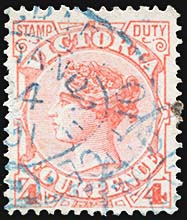 |
|
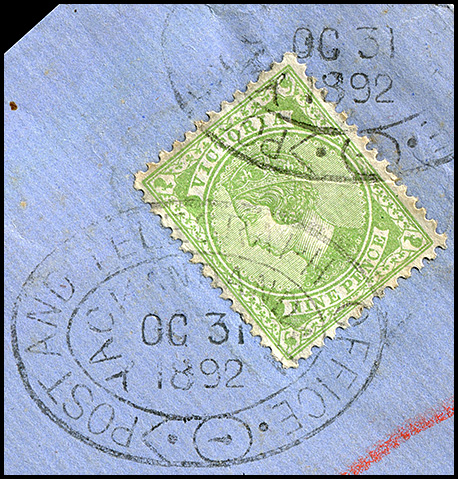 Detail of the two 1 hole Belt & Buckle strikes in black on the cover below. |
Chartwell collection, Spink May 2018, Lot 344. |
|
